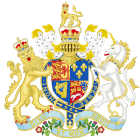The Civil List Act 1760 (1 Geo. 3. c. 1) was an Act of the Parliament of Great Britain passed upon the accession of George III.
 | |
| Long title | An Act for the Support of his Majesty's Household, and of the Honour and Dignity of the Crown of Great Britain. |
|---|---|
| Citation | 1 Geo. 3. c. 1 |
| Territorial extent | England and Wales; Scotland |
| Dates | |
| Royal assent | 9 December 1760 |
| Repealed | 15 July 1867 |
| Other legislation | |
| Repealed by | Statute Law Revision Act 1867 |
Status: Repealed | |
The Act transferred almost all civil list revenues (mainly customs and excise) to Parliament. In the last year of George II's reign these had been worth £876,988. In return, the new king received a fixed, annual civil list of £800,000.[1] Under George II the economy had grown and consequently the revenues increased. The fixed amount George III received was therefore a reduction in the Civil List.[1]
If the previous arrangement had been retained, George III's civil list in 1777 would have been more than £1,000,000 and would have amounted to £1,812,308 in 1798.[1] The £800,000 stipulated in the Act was soon found to be inadequate and a civil list crisis was only averted in the early 1760s because George II had built up savings worth £172,000 that George III was able to draw on.[2] By the end of the decade the civil list arrears amounted to more than half a million pounds and the king had to apply to Parliament to pay it off.[3]
Notes
edit- ^ a b c Reitan (1966), p. 323.
- ^ Reitan (1966), p. 324.
- ^ Reitan (1966), pp. 324–325.
Bibliography
edit- Reitan, E. A. (1966). "The Civil List in Eighteenth-Century British Politics: Parliamentary Supremacy versus the Independence of the Crown". The Historical Journal. 9 (3). Cambridge University Press: 318-337. JSTOR 2637984.